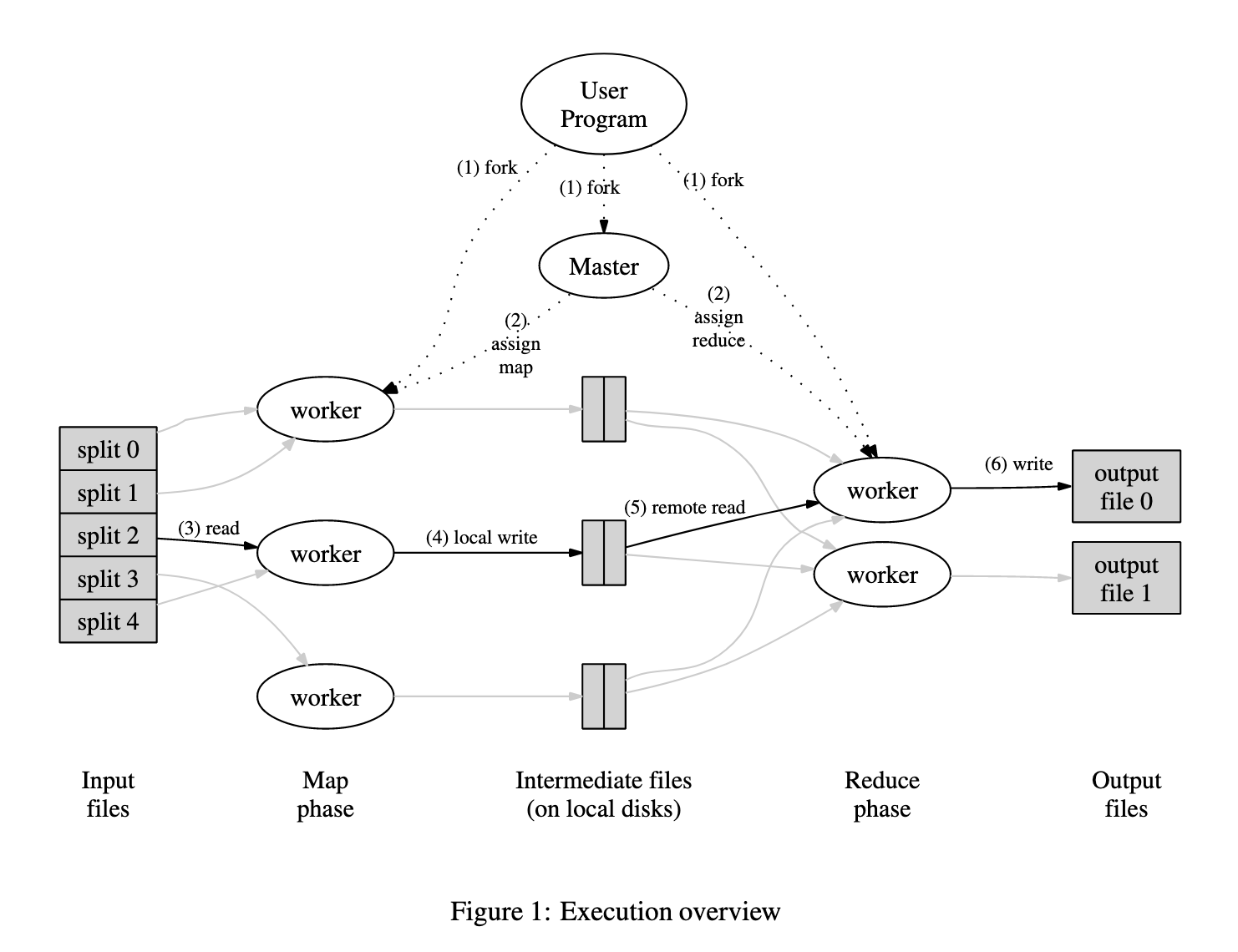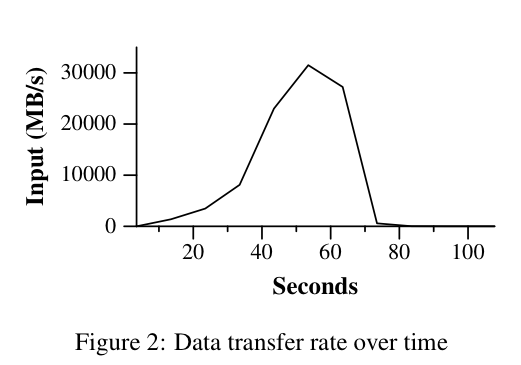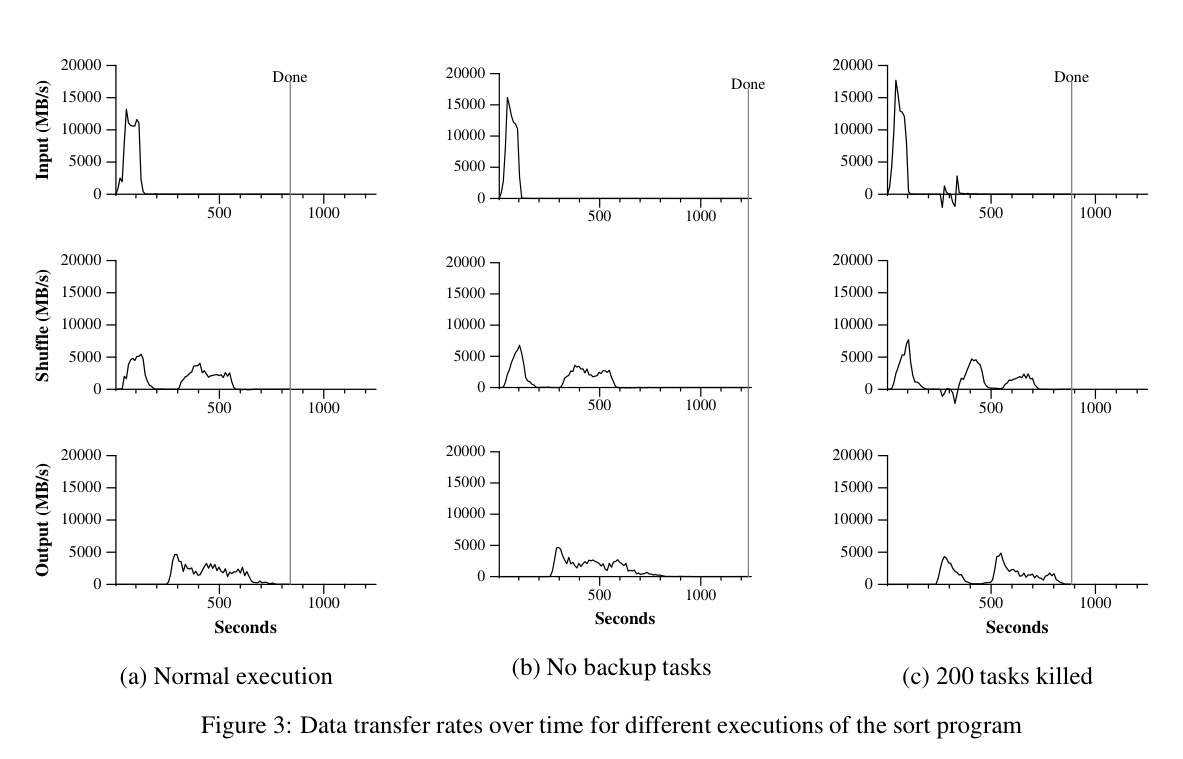MapReduce
http://static.googleusercontent.com/media/research.google.com/en//archive/mapreduce-osdi04.pdf
Introduction
-
Use cases
- At Google: process large datasets to generate
- Inverted indices
- Graph structure of web page links in various forms
- Summarize crawl statistics per host
- Most frequent queries per day
- In general:
- Large scale ML
- Clustering problems (Google News)
- Extracting data for Google Zeitgeist
- Extract data from web pages (eg. location clues for localized search)
- Large scale graph computations
- Others
- Distributed grep: map performs local filtering, reduce is a no-op
- Reverse web-link graph: map outputs
(target, source)pairs for each link totargetin a source page. Reduce concatenates to end with(target, list(source))pairs. - Inverted index: Map produces
(word, document ID)pairs, reduce concatenates & sorts to end with(word, list(doc ID)).
- At Google: process large datasets to generate
-
MR is an abstraction that attempts to hide the impl. details of parallelization, fault-tolerance, data distribution, and load balancing for batch computation
-
The design is optimizing for network bandwidth above all else
-
We realized that most of our computations involved applying a map operation to each logical “record” in our input in order to compute a set of intermediate key/value pairs, and then applying a reduce operation to all the values that shared the same key, in order to combine the derived data appropriately.
-
Re-execution is the primary mechanism for fault-tolerance
-
Intermediate output can be larger than memory
-
Pseudo-code for word-count MR functions:
map(String key, String value): # key: document name # value: document contents for each word w in value: EmitIntermediate(w, "1") reduce(String key, Iterator values): # key: a word # values: a list of counts int result = 0 for each v in values: result += ParseInt(v) Emit(AsString(result)) -
Many implementations are possible based on the computing environment.
-
Google uses clusters of PCs connected by switched Ethernet.
- Dual-processor x86, Linux, 2-4GB RAM. (Cores?)
- Commodity networking, 100 megabit - 1 gigabit per machine.
- Clusters contain 100s-1000s of machines, so failures are common
- Storage is entirely on spinning disks via IDE (2004!)
Implementation
Execution
Execution Overview
- Partition input data into $M$ splits; this is the number of map operations
- The number of reduces $R$ is manually set, but can’t be larger than the number of unique intermediate $K$s. A partitioning function translates from the keyspace to a given instance of the reduce fn.
- $M$ and $R$ should ideally be much larger than the number of worker machines. The master makes $O(M + R)$ scheduling decisions and stores $O(M * R)$ state in msortemory, so there’s a tradeoff here to consider.
- $R$ is generally kept small because it controls the number of output files
- $M$ is typically set to the number of 64MB chunks you can divide your input into
- Google often uses $M = 200,000$ and $R = 5,000$ with 2000 workers
- Each worker can perform different tasks; there aren’t technically disjoint sets of “map workers” and “reduce workers”.
- Intermediate output is divided into $R$ sections; each reduce worker grabs its section from each map worker’s output, combines all these files, and sorts them (possibly not in-memory) by key.
- The reduce worker then iterates over this sorted output and passes all values for each key to the reduce fn. Output is appended to a single output file for this worker.
- Final output is $R$ files
- The master receives locations of intermediate output as map tasks complete. This data is incrementally passed to reduce workers.
- This seems to imply that a reduce worker can start processing intermediate output (but not finish the entire reduce) before all maps are done.
- Not sure if the reduce worker can do anything except downloading intermediate output (+ possibly start sorting if using an incremental sort like merge sort) until all maps are done.
- Stragglers can hurt overall performance - one worker that is struggling, for example
- When the entire job is close to completion, the master schedules backup executions of the remaining in-progress tasks, and output from either the backup or the original executions can be used.
- Backup-less execution has caused slowdowns on the order of 44% for some jobs.
Fault Tolerance
- The master pings each worker; workers that don’t respond are marked failed
- All completed map tasks on the worker are marked “not started”
- All in-progress tasks on the worker are marked “not started”
- If a map task is re-executed, all reduce workers need to be notified.
- The master can checkpoint itself and be failed over manually, but Google uses the simple approach here and just fails the job if the master goes do.
- When map and reduce are pure, MR will produce the same output as a sequential single-node implementation.
- This is possible by having map and reduce workers mark completion atomically, by using temporary files and renaming them at the end.
Locality
- GFS splits up data into 64MB chunks and replicates them (rf=3), so the master tries to assign map tasks to workers in a way that maximizes reads off local disks.
- If that isn’t possible, the next best thing is to read a chunk from a “closer” machine, which might mean a machine connected to the same switch.
Refinements
- Custom partitioning logic so all URLs from a given host go to the same reducer (and therefore the same output file), for example
- Reducers sort by key before running the reduce operation, so they could also sort by (key, value) to provide ordering guarantees per-key.
- A combiner function is a piece of code that perfoms early/partial processing during the map task.
- The same function can be (this is typical) passed as both the reduce and combiner functions.
- For the word count job, this converts thousands of
(the, 1)entries in the intermediate output for a single map task to a single(the, 5000)entry, for example.
Performance
In this section we measure the performance of MapReduce on two computations running on a large cluster of machines. One computation searches through approximately one terabyte of data looking for a particular pattern. The other computation sorts approximately one terabyte of data.
These two programs are representative of a large subset of the real programs written by users of MapReduce one class of programs shuffles data from one representation to another, and another class extracts a small amount of interesting data from a large data set.
-
Test config
- 1800 machines, 2GHz Xeon, 4GB RAM (1-1.5GB used for other tasks on the same cluster), 2x160GB HD, gigabit ethernet
- Two-level tree-haped switched network, 200Gbps bandwidth at the root
- All machines in the same datacenter, <1ms latency
-
- Scan through $10^{10}$ 100-byte records; the pattern appears in ~92k records
- 150 seconds in total, including 1 minute in start-up overhead (!)
- Overhead includes: propagating the user code to all workers and GFS overhead for calculations around locality optimization
-
- The map function extracts a sort key and emits (sort key, record)
- The reduce function is a no-op
- The ordering guarantee (see PaperRefinements) gives us a sorted set of values per key.
-
Not sure I understand this (⌄⌄⌄⌄⌄); doesn’t the sort key implicitly define these split points? 🤔
Our partitioning function for this benchmark has builtin knowledge of the distribution of keys. In a general sorting program, we would add a pre-pass MapReduce operation that would collect a sample of the keys and use the distribution of the sampled keys to compute splitpoints for the final sorting pass.
-
In the image above:
- The top row is the rate at which input is read
- The middle row is the rate at which data is sent from the map tasks to the reduce tasks
- The bottom row is the rate at which sorted data is written to the final output files
- Reduce tasks receive data before all map tasks are done, but output doesn’t happen until all map tasks are done
- Final output rate is relatively low because it (synchronously) writes to GFS at rf=2
-
Experience
- MapReduce was used at the time of writing to build Google’s search index
- Raw crawl data (20TB) is put into GFS and used as the initial input
- Indexing is composed of 5-10 MR jobs in series
Conclusions
We have learned several things from this work.
- First, restricting the programming model makes it easy to parallelize and distribute computations and to make such computations fault-tolerant.
- Second, network bandwidth is a scarce resource. A number of optimizations in our system are therefore targeted at reducing the amount of data sent across the network: the locality optimization allows us to read data from local disks, and writing a single copy of the intermediate data to local disk saves network bandwidth.
- Third, redundant execution can be used to reduce the impact of slow machines, and to handle machine failures and data loss.


